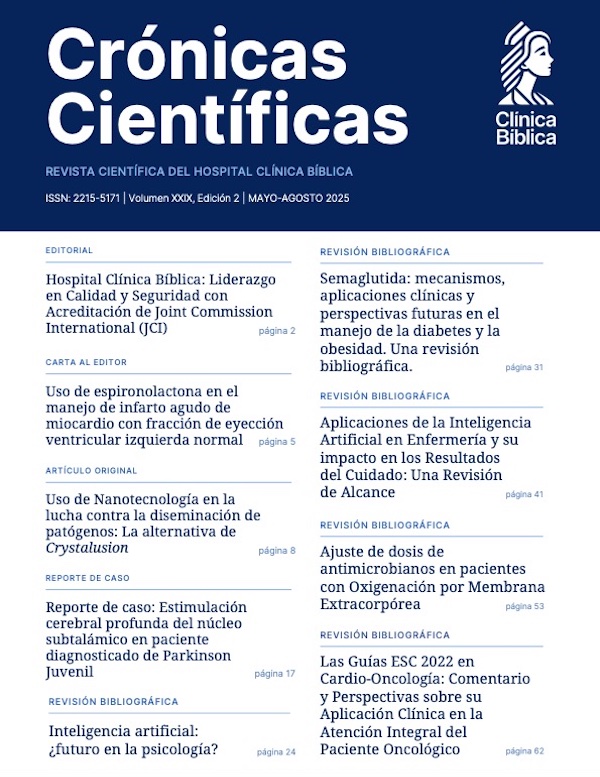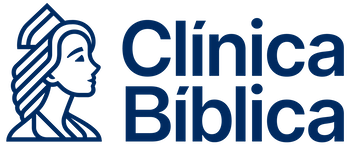- Visto: 908
Revisión Bibliográfica
Generalidades de lesión cerebral traumática en población geriátrica
Overview of traumatic brain injury in the geriatric population
DOI: https://doi.org/10.55139/QZNJ5926
APA (7ª edición)
Angulo Sibaja, S., Ramírez Barrantes, F., & Argüello Vargas, M. (2021). Generalidades de lesión cerebral traumática en población geriátrica. Crónicas científicas, 20(20), 38-47. https://doi.org/10.55139/QZNJ5926.
Vancouver
Angulo Sibaja S, Ramírez Barrantes F, Argüello Vargas M. Generalidades de lesión cerebral traumática en población geriátrica. Cron cient. 10 de octubre de 2021; 20(20):38-47.
Dr. Sebastián Angulo Sibaja
Médico general.
Licenciatura en Medicina y Cirugía. Universidad Hispanoamericana. San José, Costa Rica.
Miembro del Colegio de Médicos y Cirujanos de Costa Rica. San José, Costa Rica.
Médico Asistente General del Servicio de Emergencias en el Hospital San Vicente de Paul. Heredia, Costa Rica. Caja Costarricense del Seguro Social (CCSS). San José, Costa Rica.
Profesor adjunto de la cátedra de Fisiología de la Universidad Internacional de las Américas (UIA). San José, Costa Rica.
Dra. Fátima Ramírez Barrantes
Médico General.
Licenciatura en Medicina y Cirugía. Universidad de Ciencias Médicas, (UCIMED). San José, Costa Rica.
Miembro del Colegio de Médicos y Cirujanos de Costa Rica. San José, Costa Rica.
Médico Asistente General en el Servicio de Emergencias en el Hospital San Vicente de Paul. Heredia, Costa Rica. Caja Costarricense del Seguro Social (CCSS). San José, Costa Rica.
Dra. Marilyn Argüello Vargas
Médico General.
Licenciatura en Medicina y Cirugía. Universidad de Ciencias Médicas, (UCIMED). San José, Costa Rica.
Miembro del Colegio de Médicos y Cirujanos de Costa Rica. San José, Costa Rica.
Médico Asistente General del Servicio de Emergencias en el Hospital San Vicente de Paul. Heredia, Costa Rica. Caja Costarricense del Seguro Social (CCSS). San José, Costa Rica.
Resumen
La lesión cerebral es una patología frecuente en todos los grupos etarios, sin embargo, la población adulta mayor es más propensa que el resto a sufrir complicaciones. La edad, comorbilidades asociadas, medicación anticoagulante y cambios fisiológicos propios del adulto mayor son factores de riesgo de mal pronóstico a corto, mediano y largo plazo. Durante el abordaje inicial de un paciente geriátrico, se debe tomar en cuenta una serie de elementos para la adecuada clasificación de severidad, tal como la realización de la escala de Glasgow y evaluación inicial de trauma; dado que la no consideración de deterioros cognitivos previos, patologías oftalmológicas y otros elementos, puede conllevar a una valoración inadecuada. El manejo terapéutico corresponderá al grado documentado de lesión cerebral según escalas de severidad, sin embargo, el que representa mayor reto terapéutico corresponde a aquellos con lesión cerebral traumática leve, siendo que la realización de estudios de imagen orientada y valoración clínica continua, juegan un papel importante en la determinación de disposición del paciente. La presente revisión pretende brindar conocimientos básicos que permitan, en el contexto de un paciente adulto mayor, un abordaje y diagnóstico expedito a fin de evitar complicaciones relacionadas a la lesión cerebral traumática.
Palabras claves
Lesión cerebral traumática, adulto mayor, manejo, generalidades.
Abstract
Traumatic brain injury is a common pathology in all age groups; however, the older adult population is more prone to complications than the rest. Age, associated comorbidities, anticoagulant medication, and physiological changes typical of the elderly are risk factors for poor prognosis in the short, medium, and long term. During the initial approach to a geriatric patient, a series of elements must be considered for the adequate classification of severity, such as the performance of the Glasgow Scale and initial evaluation of trauma; given that the non-consideration of previous cognitive impairments, ophthalmological pathologies and other elements can lead to an inadequate assessment. Therapeutic management will correspond to the documented degree of brain injury according to severity scales, however, the one that represents the greatest therapeutic challenge corresponds to those with mild traumatic brain injury, and the performance of targeted imaging studies and continuous clinical evaluation play an important role in determining patient disposition. The present review aims to provide basic knowledge that allows, in the context of an elderly patient, an expeditious approach and diagnosis to avoid complications related to traumatic brain injury.
Keywords
Traumatic brain injury, elderly, management.
Bibliografía
1. Menon DK, Schwab K, Wright DW, Maas AI. Demographics and Clinical Assessment Working Group of the International and Interagency Initiative toward Common Data Elements for Research on Traumatic Brain Injury and Psychological Health. Position statement: definition of traumatic brain injury. Arch Phys Med Rehabil. 2010; 91(11):1637–40.
2. Khellaf A, Khan DZ, Helmy A. Recent advances in traumatic brain injury. J Neurol. 2019; 266(11):2878–89. Disponible en: https://doi.org/10.1007/s00415-019-09541-4
3. Bryan-Hancock C, Harrison J. The global burden of traumatic brain injury: preliminary results from the Global Burden of Disease Project. Inj Prev. 2010;16(Supplement 1):A17–A17.
4. Hukkelhoven CWPM, Steyerberg EW, Rampen AJJ, Farace E, Habbema JDF, Marshall LF, et al. Patient age and outcome following severe traumatic brain injury: an analysis of 5600 patients. J Neurosurg. 2003;99(4):666–73.
5. Llompart-Pou JA, Pérez-Bárcena J, Chico-Fernández M, Sánchez-Casado M, Raurich JM. Severe trauma in the geriatric population. World J Crit Care Med. 2017; 6(2):99–106. Disponible en: https://doi.org/10.5492/wjccm.v6.i2.99
6. Diaz Mazariegos JJ, Petgrave Perez A, Padilla Cuadra J. Perfil epidemiológico y factores de riesgo asociados a mortalidad por traumatismo craneoencefálico en el servicio de neurocirugía del hospital Dr. R.A. Calderón Guardia durante el período 2007 al 2012. Rev Clín Esc Med UCR-HSJD [Internet]. 2016; 5(6). Disponible en: http://dx.doi.org/10.15517/rc_ucr-hsjd.v5i6.22947
7. Vargas Sanabria M, Bonilla Montero RA. El trauma cráneo encefálico como causa de muerte violenta en Costa Rica en el año 2004. Medicina Legal de Costa Rica. 2006; 23(1):113–128.
8. Richmond R, Aldaghlas TA, Burke C, Rizzo AG, Griffen M, Pullarkat R. Age: is it all in the head? Factors influencing mortality in elderly patients with head injuries. J Trauma. 2011; 71(1):E8– 11.
9. Karibe H, Hayashi T, Narisawa A, Kameyama M, Nakagawa A, Tominaga T. Clinical characteristics and outcome in elderly patients with traumatic brain injury: For establishment of management strategy. Neurol Med Chir (Tokyo). 2017; 57(8):418–25.
10. Mak CHK, Wong SKH, Wong GK, Ng S, Wang KKW, Lam PK, et al. Traumatic Brain Injury in the Elderly: Is it as Bad as we Think? Curr Transl Geriatr Exp Gerontol Rep. 2012; 1(3):171–8.
11. Utomo WK, Gabbe BJ, Simpson PM, Cameron PA. Predictors of in-hospital mortality and 6-month functional outcomes in older adults after moderate to severe traumatic brain injury. Injury. 2009; 40(9):973–7.
12. Peeters W, van den Brande R, Polinder S, Brazinova A, Steyerberg EW, Lingsma HF, et al. Epidemiology of traumatic brain injury in Europe. Acta Neurochir (Wien). 2015; 157(10):1683–96.
13. Ng SY, Lee AYW. Traumatic brain injuries: Pathophysiology and potential therapeutic targets. Front Cell Neurosci. 2019; 13:528. Disponible en: https://doi.org/10.3389/fncel.2019.00528
14. Sulhan S, Lyon KA, Shapiro LA, Huang JH. Neuroinflammation and blood-brain barrier disruption following traumatic brain injury: Pathophysiology and potential therapeutic targets. J Neurosci Res. 2020; 98(1):19–28. Disponible en: https://doi.org/10.1002/jnr.24331
15. Jha RM, Kochanek PM, Simard JM. Pathophysiology and treatment of cerebral edema in traumatic brain injury. Neuropharmacology. 2019; 145(Pt B):230–46.
16. Aalami OO, Fang TD, Song HM, Nacamuli RP. Physiological features of aging persons. Arch Surg. 2003; 138(10):1068–76.
17. Testa JA, Malec JF, Moessner AM, Brown AW. Outcome after traumatic brain injury: effects of aging on recovery. Arch Phys Med Rehabil. 2005;86(9):1815–23. Disponible en: https://doi.org/10.1016/j.apmr.2005.03.010
18. Firląg M, Kamaszewski M, Gaca K, Bałasińska B. Age-related changes in the central nervous system in selected domestic mammals and primates. Postepy Hig Med Dosw. 2013; 67:269–75. Disponible en: https://doi.org/10.5604/17322693.1044490
19. Griffiths MR, Gasque P, Neal JW. The regulation of the CNS innate immune response is vital for the restoration of tissue homeostasis (repair) after acute brain injury: a brief review. Int J Inflam. 2010; 2010:151097.
20. MRC CRASH Trial Collaborators, Perel P, Arango M, Clayton T, Edwards P, Komolafe E, et al. Predicting outcome after traumatic brain injury: practical prognostic models based on large cohort of international patients. BMJ. 2008; 336(7641):425–9.
21. Lin M, Lin S-L, Wang K-L, Kuo H-W, Tak T. Effect of aging on human circulatory system in normotensive healthy subjects. Int J Angiol. 2014; 23(4):233–42.
22. Sharma G, Goodwin J. Effect of aging on respiratory system physiology and immunology. Clin Interv Aging. 2006; 1(3):253–60.
23. Stein, D. M., Kozar, R. A., Livingston, D. H., Luchette, F., Adams, S. D., Agrawal, V., Arbabi, S., Ballou, J., Barraco, R. D., Bernard, A. C., Biffl, W. L., Bosarge, P. L., Brasel, K. J., Cooper, Z., Efron, P. A., Fakhry, S. M., Hartline, C. A., Hwang, F., Joseph, B. A., … Committee, O. behalf of the A. G. T. Geriatric traumatic brain injury—what we know and what we don’t. Journal of Trauma and Acute Care Surgery. 2018; 85(4), 788798. Disponible en: https://doi.org/10.1097/TA.0000000000001910
24. Nentwich LM, Grimmnitz B. Neurologic emergencies in the elderly. Emerg Med Clin North Am. 2016; 34(3):575–99.Disponible en: https://doi.org/10.1016/j.emc.2016.04.009
25. Marrone F, Zavatto L, Allevi M, Di Vitantonio H, Millimaggi DF, Dehcordi SR, et al. Management of mild brain trauma in the elderly: Literature review. Asian J Neurosurg. 2020;15(4):809–20. Disponible en: https://doi.org/10.4103/ajns.AJNS_205_20
26. Abdelmalik PA, Draghic N, Ling GSF. Management of moderate and severe traumatic brain injury. Transfusion. 2019; 59(S2):1529–38.
27. Dixon J, Comstock G, Whitfield J, Richards D, Burkholder TW, Leifer N, et al. Emergency department management of traumatic brain injuries: A resource tiered review. Afr J Emerg Med. 2020; 10(3):159–66. Disponible en: https://doi.org/10.1016/j.afjem.2020.05.006
APA (7ª edición)
Angulo Sibaja, S., Ramírez Barrantes, F., & Argüello Vargas, M. (2021). Generalidades de lesión cerebral traumática en población geriátrica. Crónicas científicas, 20(20), 38-47. https://doi.org/10.55139/QZNJ5926.
Vancouver
Angulo Sibaja S, Ramírez Barrantes F, Argüello Vargas M. Generalidades de lesión cerebral traumática en población geriátrica. Cron cient. 10 de octubre de 2021; 20(20):38-47.
Esta obra está bajo una licencia internacional Creative Commons: Atribución-NoComercial-CompartirIgual 4.0 Internacional (CC BY-NC-SA 4.0)

Realizar búsqueda
Última Edición
Ediciones






